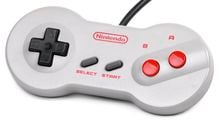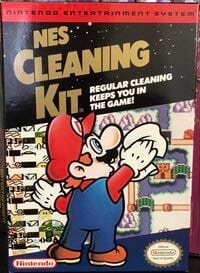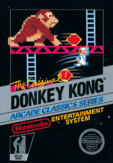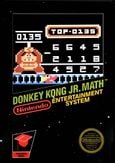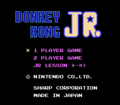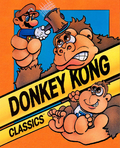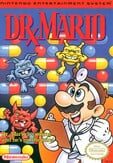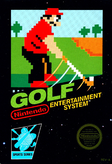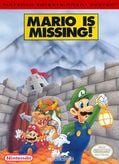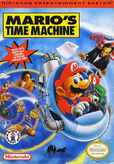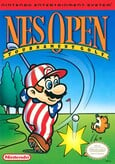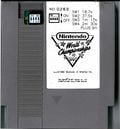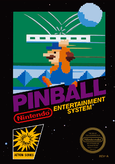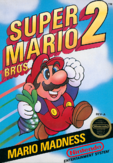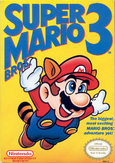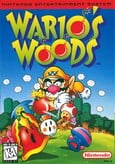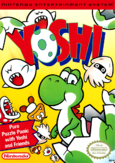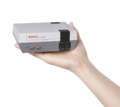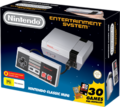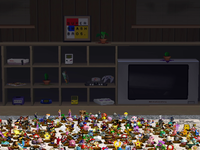Nintendo Entertainment System
It has been requested that this article be rewritten. Reason: Needs general reorganization
- "NES" redirects here. It is not to be confused with Ness.
- This article is about the first Nintendo console. For the treasure from Wario World, see List of treasures in Wario World#Greenhorn Ruins.
- “Now you're playing with power!”
- —Advertisement slogan for the NES
The Nintendo Entertainment System (known as the NES for short) is a third generation home video game console created by Nintendo. It is the western version of the Family Computer (aka the Famicom), and has controllers that can be removed (unlike the Famicom). Games are inserted by opening a door and sliding the game in, then pushing a panel down.
It was the system that revived the video game industry after the video game crash of 1983. It rivaled against the Sega Master System and the Atari 7800 until the release of the Super Nintendo Entertainment System ushered in the next generation of video game consoles. The NES sold over 60.91 million units worldwide during its lifetime and was discontinued in 1995.[1]
The Nintendo Entertainment System was bundled with Super Mario Bros., resulting in it being the console's most successful game. For decades, Super Mario Bros. was the highest-selling video game ever, with 40.23 million copies sold, until Nintendo packaged Wii Sports with the Wii. Eventually, Super Mario Bros. 3 was released in the USA, and it became an instant hit, making five hundred million dollars in less than twenty-four hours. It soon became the second most purchased game in the gaming world with over 18 million copies sold.
Due to the lack of security, many NES games have become pirated, creating games such as 999-in-1.
In America, the NES was sold in three packages:
- Control Deck: Contained the console, two controllers, the Super Mario Bros. cartridge and the needed connections.
- Action Set: This set included the console, two controllers, the Super Mario Bros./Duck Hunt cartridge, the NES Zapper, and the connections.
- Power Set: The most complete package, it contained the console, two controllers, a Super Mario Bros./Duck Hunt/World Class Track Meet cartridge, the Zapper, the Power Pad, and the connections.
Hardware
The NES/Famicom hardware consists of 2 kilobytes of onboard RAM, a custom second source MOS Technology 6502 based processor (called the Ricoh 2A03 in NTSC regions and the 2A07 in the PAL regions) which has a built in sound generator on chip and is used as the main processor. The Ricoh 2A03/2A07 contains 5 channels of sound: 1 triangle channel, 2 square wave channels, 1 noise channel and 1 DPCM channel for playing samples from memory. The Ricoh 2A03/2A07 is essentially the same as a regular 6502 but with the binary code decimal mode removed.
The video generator hardware is the Picture Processing Unit (PPU) (Ricoh 2C02 "NTSC"/Ricoh 2C07 "PAL") which is responsible for generating the sprites and background images onscreen. Graphical capabilities, extended RAM and even sound capabilities can be expanded with the use of memory mappers like the MMC2, 3, 4, 5 and Konami VRC6 among other mappers. For instance, the MMC5 adds 2 extra pulse wave channels and another Raw PCM channel in addition to the main 2A03/2A07 channels; the Konami VRC6 adds a sawtooth wave channel and 2 extra square waves and the VRC7 adds FM Synthesis capabilities which is based on the Yamaha YM2413 OPLL FM Synthesizer and is a derivative of the OPLL chip.
The only 2 Mario games that use memory mappers are Super Mario Bros. 2 and Super Mario Bros. 3 with the MMC3 mapper being used. The only Mario cameo appearance that uses memory mappers is Mike Tyson's Punch-Out!! with the MMC2 being used, which is also the only NES game that uses that particular mapper.
Accessories
NES Controller
The NES controller is the basic controller that comes with the console. It has four buttons and and a directional pad on a brick shaped case. and
are stationed on the right with the
and
in the middle. The D-pad, first used on the Game & Watch to replace bulky joysticks, are on the left of the controller.
There were various versions of the NES controller. Nintendo released the NES Max and the NES Advantage, the latter of which had a "slow" button and both of which featured "turbo" buttons which, when held, would represent a button being pressed repeatedly. Nintendo later released a different form of the NES, which used a "dog-bone" design instead of the brick design. This design combines elements of the Game Boy and the Super Nintendo Entertainment System controller.
NES Zapper
The NES Zapper was a light gun accessory used for only a small number of games, the most notable one being Duck Hunt. The first version of the Zapper to release was the gray one, but since a soldier mistook it for a real gun, Nintendo rereleased it in orange.
The Zapper is also used in Duck Hunt's moveset in Super Smash Bros for Nintendo 3DS / Wii U and Super Smash Bros. Ultimate, although since the character wielding the light gun is never seen in-game, its only real appearance is in the character reveal trailer for Duck Hunt in Super Smash Bros for Nintendo 3DS / Wii U.
Power Glove
The Power Glove was a handheld glove controller that used hand movements as a controller via conductive ink. It also had a keypad that defaulted certain buttons to certain hand movements. Under it featured the normal buttons on the NES controller. It sold poorly and was criticized for being imprecise. It was featured in the movie The Wizard.
R.O.B.
- Main article: R.O.B.
Cleaning Kit
Over time, pins inside the NES and game cartridges would get dirty. Nintendo released an approved cleaning kit to improve the condition of the contacts so games would play without interruption.
NES Classic Edition
- Main article: Classics#NES Classic Edition
Announced on July 14, 2016, the NES Classic Edition (known as the Nintendo Classic Mini: Nintendo Entertainment System in Europe and Australia) is a smaller version of the Nintendo Entertainment System, and the first entry to the Classics series. It was released in Australia on November 10, 2016, and in the Americas and Europe on November 11, 2016.[2] Unlike the original NES, the NES Classic Edition does not support cartridges, but rather features 30 games pre-installed, including Mario games such as Super Mario Bros., Donkey Kong and Dr. Mario. A version for the Japanese Family Computer, the Nintendo Classic Mini: Family Computer, was released in Japan on the same day, and includes a slightly different software line-up than the NES Classic Edition.
The NES Classic Edition was discontinued on April 2017 [3], but resumed production in Summer 2018.[4] On June 26, 2017, a successor was announced in the form of the SNES Classic Edition.[5]
Game gallery
Please note that this gallery also includes Japan-only Family Computer games.
- Donkey Kong Jr. NES Cover.png
- DK3 Cover.jpg
- Mario Bros. NES Cover.png
- NCC Cartridge Repro.png
- SMB Boxart.png
- Wrckcover.jpg
Hardware gallery
- NES Logo.png
Alternate logo
Appearances in the Mario franchise
- At the beginning of the The Super Mario Bros. Super Show! episode "Mama Mia Mario", as Mario and Luigi are relaxing in front of the TV, Luigi is seen holding an NES controller.
- The NES appears as one of Wario's treasures in Wario World.
- 9-Volt has an NES in WarioWare: Twisted!
- In Super Paper Mario, one of Francis's protected rooms has an NES, along with various other Nintendo consoles.
- In Mario + Rabbids Kingdom Battle, the design on the carpet in the Genius Girl's room is based on the NES controller.
- Though the console itself doesn't appear in Super Mario Odyssey, one of the filters that is available for use in Snapshot Mode is the graphics style of the NES.
Name in other languages
| Language | Name | Meaning |
|---|---|---|
| Japanese | ファミリーコンピュータ Famirī Konpyūta ファミコン Famikon |
Family Computer Famicom |
| Korean | 현대 컴보이 Hyeondae Keomboi |
Hyundai Comboy |
| Spanish (NOA) | Nintendo Entertainment System |
|
| Spanish (NOE) | Sistema de Entretenimiento de Nintendo |
Literal translation. |
Trivia
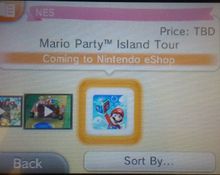
- An NES controller appears as one of the tokens in the 2006 and 2007 version of Nintendo Monopoly.
- The NES is placed in the 1st spot of IGN's Top 25 Game Consoles.
- A large NES controller appears in Wreck-It Ralph as a door leading to the coding of the game Sugar Rush, which the character King Candy opens by putting in the Konami code (up, up, down, down, left, right, left, right, B, A, start), a very famous button input that was put in as a cheat in numerous Konami games, first appearing in Gradius (1986).
- An expansion port is located underneath the console. However, no accessories were used for it. Although the Famicom Disk System was planned for a North American release and if released it would have used the Expansion Port. However, the redesigned NES-101 Top Loader model lacks the expansion port entirely.
- For a time, the Nintendo 3DS eShop mistakenly stated Mario Party: Island Tour to be a title on the NES.
- The NES port of Wario's Woods is the only NES game with an ESRB rating, due to it being released so late in the console's run.
- Biederman Design Labs Research & Development was working on a handheld NES console called the Nintendo Express, but it never got released. Almost no screenshots were taken of it.[6] On the source video's comment section, a YouTuber by the name of Rick Gordon said he worked with Paul Biederman on occasion. He also said there was a version that had a crosspad. He went on to say that Paul went directly to Nintendo, who would not approve of the system, due to the upcoming Game Boy. He lastly said that because of this, Biederman Design Labs went to Galoob who looked at it, but the toy company did not want to enter another legal fight with Nintendo.
References
- ^ http://www.webcitation.org/5nXieXX2B
- ^ Nintendo. (July 14, 2016). Nintendo Classic Mini: Nintendo Entertainment System. Nintendo UK. Retrieved July 14, 2016.
- ^ http://www.ign.com/articles/2017/04/13/nintendo-discontinues-the-nes-classic-edition?abthid=58efc43a733f92f66f00000d
- ^ http://www.nintendolife.com/news/2017/09/nintendo_is_resurrecting_the_nes_classic_mini_and_increasing_snes_classic_inventory
- ^ http://www.nintendo.com/super-nes-classic
- ^ [1] Unreleased Consoles|Nintendo Express - YouTube Channel Evil Pixel
| Video game consoles and add-ons | |
|---|---|
| Nintendo home consoles | Nintendo Entertainment System/Family Computer (Family BASIC, Family Computer Disk System) • Super Nintendo Entertainment System/Super Famicom (Satellaview, Super Game Boy) • Nintendo 64 (Nintendo 64DD) • Nintendo GameCube (Game Boy Player) • Wii (Virtual Console, WiiWare) • Wii U (Virtual Console) |
| Nintendo handhelds | Game & Watch • Game Boy • Virtual Boy • Game Boy Color • Game Boy Advance • Nintendo DS (Nintendo DSi, DSiWare) • Nintendo 3DS (Virtual Console) |
| Other | MS-DOS • VS. System • Nintendo PlayChoice-10 • Nelsonic Game Watch • Super Mario Bros. Watch • Gamewatch Boy • Philips CD-i • Mini Classics • Nintendo Switch • Triforce • Visteon Dockable Entertainment System • Classics • LodgeNet |

